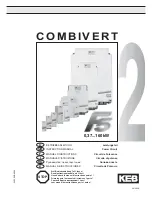
CG635 Remote Programming
39
CG635 Synthesized Clock Generator
CESE(?){i}
Communication Error Status Enable
Set (query) the communications error status enable register {to i}. Bits set in this
register cause CESB in the serial poll status byte to be set when the
corresponding bit is set in the communications error status register (CESR).
CESR?
Communication Error Status Register
Query the communications error status register. The value returned is a decimal
value from 0 to 255. After executing a CESR? query, the register is cleared. See
the Status Byte Definitions section for a description of each of the bits.
Example
CESR?<CR>
A return of ‘24’ would indicate that OR and OVFL bits are
set. OR indicates that a character was received over RS-232
before the microcontroller had time to process the previous
character. OVFL indicates that the input buffer overflowed.
INSE(?){i}
Instrument Status Enable
Set (query) the instrument status enable register {to i}. Bits set in this register
cause INSB in the serial poll status byte to be set when the corresponding bit is
set in the instrument status register (INSR).
INSR?
Instrument Status Register
Query the instrument status register. The value returned is a decimal value from
0 to 255. After executing a INSR? query, the register is cleared. See the Status
Byte Definitions section for a description of each of the bits.
Example
INSR?<CR>
A return of ‘4’ would indicate that an eeprom write failed.
LCKE(?){i}
PLL Lock Status Enable
Set (query) the PLL lock status enable register {to i}. Bits set in this register
cause LCKB in the serial poll status byte to be set when the corresponding bit is
set in the PLL lock status register (LKCR).
LCKR?
PLL Lock Status Register
Query the PLL lock status register. The value returned is a decimal value from
0 to 255. After executing a LCKR? query, the register is cleared. See the Status
Byte Definitions section for a description of each of the bits.
Example
LCKR?<CR>
A return of ‘3’ would indicate that the RF PLL and the
19 MHz PLL have come unlocked.
LERR? Last
Error
Query the last error in the error buffer. After executing a LERR? query, the
returned error is removed from the error buffer. See the Error Codes section later
in this chapter for a description of the possible error codes returned by LERR?.
The error buffer has space to store up to 20 errors. If more than 19 errors occur
without being queried, the 20
th
error will be 254 (Too Many Errors) indicating
that errors were dropped.
















































